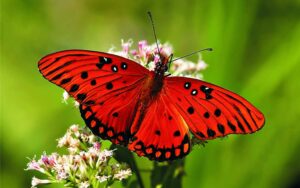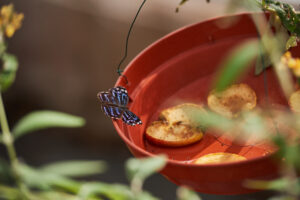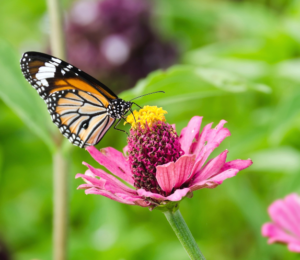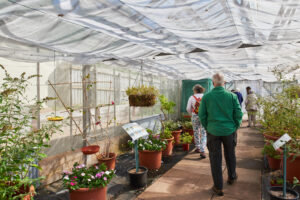How to spot butterflies in Birmingham?
Contents
- What factors are affecting butterfly populations?
- Where to see butterflies in Birmingham?
- See what you can find…
Once appearing as a frequent flutter of colours, butterflies in the UK are now a sadly declining sight.
Environmentalist organisation Butterfly Conversation revealed on Wednesday that half of Britain’s butterfly species are now threatened by extinction.
Over the past 20 years, nearly 60 percent of the UK insect population has plummeted and a staggering 71 percent of our butterflies are in long-term decline.
Along with their insect compatriots, butterflies are suffering from the rising temperature of our climate and the continued destruction of their habitat by people.
But hope is far from lost and there are still many ways to support our winged-friends as there are means to enjoy them until the end of the butterfly season.
From wetlands and bogs to urban spaces and our very own Butterfly House and guided tour taking place next month, there are still an array of places to see butterflies in Birmingham.

What factors are affecting butterfly populations?
There are a number of natural occurrences which keep butterfly populations under control – predation, disease, lifecycles, flight periods and ecology to name a few.
Unsurprisingly though, these are not the factors that are driving butterflies to extinction – this tragedy is almost single-handedly down to our own detrimental activities.
According to a survey published by the Kent Wildlife Trust, changes to land, the impact of the climate crisis, rising use of pesticides, pollution and invasive, non-native species are the core reasons for the demise of our butterflies.
Dr Richard Fox, Butterfly Conservation’s Head of Science said: “Without action it is likely that species will be lost from Britain’s landscapes for good, but Butterfly Conservation is taking bold steps to improve key landscapes for butterflies and reduce the extinction risk of many threatened species.”
Helping to support our butterfly species does not require you to become a lepidopterist (butterfly specialist) overnight though.
Instead, following these simple steps is a great way to make a small difference:
- Avoid using pesticides and insecticides in your gardens or communal green spaces
- If you have access to a private garden or regularly attend a community garden, try to plant a variety of butterfly-friendly plants which will provide nourishment and shelter
- Put up artificial nectar feeders
- Get involved or set up habitat conservation projects
- Use peat-free compost
Where to see butterflies in Birmingham
There are far more places you will spy butterflies than you think – disused industrial sites, bogs and beaches to name a few.
To help you have the best chance of seeing some of these stunning winged-creatures, we have created a simple guide to some of Birmingham’s butterfly hotspots.

Grassland and heathland
Both grassland and heathland are ideal areas for butterflies to thrive within.
Home to a wealth of biodiversity, such areas are unimproved and support the low-growing shrubs which butterflies, bees and other flying insects live for.
Grasslands also store a huge amount of carbon in their soils, helping to regulate the climate, subsequently protecting rare species for longer.
Good examples of grassland and heathland areas to spot butterflies in Birmingham are:
- Sutton park
- Lickey Hills Country park
- Cotteridge park
Wetlands, bogs and marshes
Waterlogged soils and standing water are the main features which enable some specialist species of butterflies to thrive, according to the Butterfly Convention.
This is due to the specific vegetation and food plants that grow in these environments.
Although the appearance might seem unappealing, these domains are rich with life and nutrients.
Good examples of wetland, bog and marsh areas to spot butterflies in Birmingham are:
- Moseley bog and Joy’s wood
- Berkswell marsh
- Tame valley wetlands
Woodlands and forests
Simmering with the sounds of birdsong, frog croaks and rustling leaves, woodlands and forests are always good places to check for signs of butterflies.

The varied combination of glades, open spaces, shrubby hideaways, overgrown vegetation, wild flowers and fallen trees provide the ideal butterfly playground.
Good examples of woodland and forest areas to spot butterflies in Birmingham are:
- Warley woods
- Highbury park
- Cannon hill park
Urban environments
Unusually, brownfield sites which have not been developed can be great places to see butterflies.
This is largely due to the abundance of sheltered spaces, growth of vegetation and sunbathing spots which these areas provide.
Additional urban landscapes which host these insects include churchyards, parks and road verges as well as more unique hideouts like railway lines and disused quarries according to the Butterfly Conservation.
However, it is important to stress that you should not be trekking near quarries or train tracks in your quest for sightings and that sticking to areas like Digbeth, St Philip’s Cathedral and the city centre parks are a much better and legal option!
Learn how you can protect the butterflies with a butterfly border.
Birmingham Botanical Gardens
Opened in May 2012, the Butterfly House at Birmingham Botanical Gardens has just celebrated its 10th anniversary and continues to be a magical hub for you to butterfly-watch within.
“Once our tender plants have overwintered in the Butterfly House and we have planted them outside for the summer, we always reopen the glasshouse for the butterflies at the end of May”, said head gardener Wayne Williams.
“During this period, we keep the glasshouse heated to a minimum of 16C at night to ensure our tropical butterflies are kept happy. The optimum climate for them is a humid, warm environment – 28C and 80 percent humidity is ideal.”

Raised from pupae which are brought in weekly from external suppliers and delicately placed onto bamboo canes, the butterfly species at the Gardens are largely native to the Philippines and Central America.
“Part of the fun with all of these different species is trying to identify them! As these are a mix of species from their 41 suppliers from around the world, they cannot tell us what species there will be.”
See what you can find…
If you need a great place to start you off in your quest for butterflies, head to our Butterfly House page or check out our upcoming tour in June.

